![]()
![]()
![]()
Use LEFT and RIGHT arrow keys to navigate between flashcards;
Use UP and DOWN arrow keys to flip the card;
H to show hint;
A reads text to speech;
21 Cards in this Set
- Front
- Back
- 3rd side (hint)
|
What is the prognosis of erythema multiforme |
A self-limited but often recurrent disease |
|
|
|
What is the onset of EM like |
Sudden onset of papular lesions with the vast majority of lesions appearing within 24hrs |
|
|
|
Describe the target lesions seen in EM |
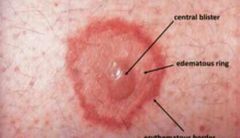
• Target lesion consists of concentric zones of colour change with evidence of damage to the epidermis in the central zone such as bulla or crust • Target lesions may have a central dusky zone and a red outer zone; some may evolve to 3 zones of colour change
|
|
|
|
What disease is the predominant precipitant of EM |
Predominant precipitant is preceding HSV (herpes simplex) infection. Thus it is a hypersensitivity reaction. (NB : in SJS the predominant preceding precipitant is not an infection but drugs) Others include: histoplasma capsulatum, mycoplasma pneumonia, hepatitis, cmv, vzv, drugs (nsaids and penicillin) |
|
|
|
Are the mucous membrane involved in EM |
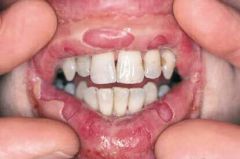
Yes
• if present, typically develop a few days after the skin rash begins. • most commonly lips, inside the cheeks, tongue
|
|
|
|
Why is EM considered as a hypersensitivity reaction |
Because one is first exposed to the stimulus and then after some lag time the reaction occurs |
|
|
|
What are the primary lesions in EM minor |
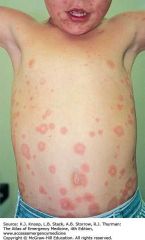
• Sudden onset of symmetrical fixed red papules • Some papules evolve into target lesions |
|
|
|
What is the key difference between EM minor and EM major |
• unlike EM major, with EM minor there is usually no prodrome except for a preceding herpetic infection. Also there may be oral lesion in Major but rarely to none in minor. |
|
|
|
Describe the prodrome phase in EM major |
Major • Mild fever, chills, joint ache • Abrupt onset of skin lesions
|
|
|
|
With EM major, at onset of disease, how long does it take for all of the lesions to be filled |
with almost all lesions appearing within 24hrs and completely by 72hrs
|
|
|
|
Describe the evolution of the primary lesions in EM major |
• Primary lesion : first as a macule, then as a papule, then as a target (note: only some of the papules transform into target lesions). |
|
|
|
In EM major, how long do the macules and papules last before transforming into target lesions |
The macule and papule phase lasts for about 7 days before the onset target lesions |
|
|
|
What is an iris lesion |
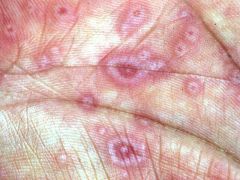
• Target lesions often develop a blister of crust in the central zone later• A few lesions may have 3 zones of colour change with a red border, white middle zone and dusky center, sometimes referred to as ‘iris lesions’
• The typical target (iris) lesion of EM has a sharp margin, regular round shape and three concentric colour zones: • Centre is dusky or dark red with a blister or crust • Next ring is a paler pink and is raised due to oedema (fluid swelling) • Outermost ring is bright red.
|
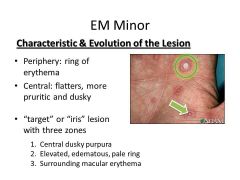
|
|
|
Where on the body are the Predilection sites for EM |
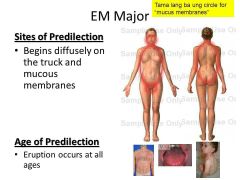
• Target lesions favour the upper extremities, as does the entire eruption of EM • Dorsa of the hands and forearms are often involved; also palms, neck, face & trunk |
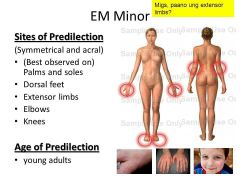
|
|
|
Is there koebner phenomenon in EM |

Yes |
|
|
|
Aside from the oral mucosa what other mucosal membranous site dos EM affect |
• Other mucosal sites are NOT involved
|
|
|
|
How long does it take before EM remits |
• For most people lesions last 2 weeks and heal without sequelae
|
|
|
|
Describe the mucous membranes involvement in EM minor |
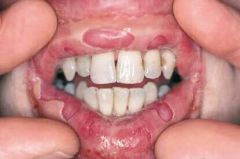
• EM minor: absent or mild( redness of the lips and inside cheek. Sometimes blisters develop and quickly break to form erosions and ulcers)
|
|
|
|
Describe the mucous membranes involvement in EM major |
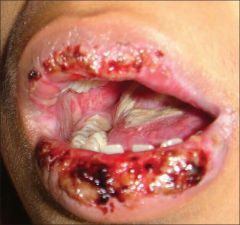
• EM major: one or more mucous membranes are typically affected, most often the oral mucosa: • most commonly lips, inside the cheeks, tongue
|
|
|
|
How would you treat the symptoms associated with EM |
• Symptomatic:Oral antihistamine will reduce stinging & burning and itchingOral acyclovir prophylaxis for recurrencesI.e. treat the symptoms and wait for the disease to remit |
|
|
|
Dose of acyclovir for immune compromised people |
200mg 5x a day for 5 days (10 days for very serious cases) |
|

